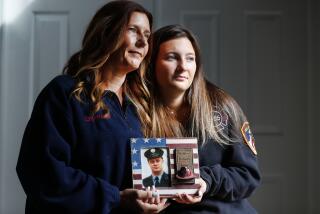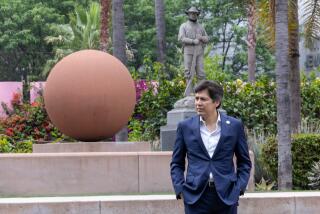ART : COMMENTARY : A Stitch in Time : The NAMES Project AIDS Memorial Quilt returns to Washington, its 21,000 panels casting a shadow that reaches the White House
They’re bringing the Quilt back to Washington.
Again.
When the NAMES Project AIDS Memorial Quilt was first laid out on the Capitol Mall in October, 1987, during the mammoth National March for Lesbian and Gay Rights, its 1,920 panels covered a space larger than two football fields. Conceived two years before in San Francisco by activist Cleve Jones, who wanted a way to publicly eulogize a friend, the quilt had grown with dizzying speed.
Friends, relatives, loved ones, spouses and the euphemistic “longtime companions” of men and women who had succumbed to AIDS rallied around the idea. Because in the United States gay men had been hardest hit by the epidemic, the project offered a means for replacing with love the cruel stigma that surrounded the disease. In each hand-stitched panel the wicked image of a demon had been wiped away by the singular face of a human being. Out there on the Capitol Mall, the quilt bore silent, shocking witness to the thousands of lives lost and to the exponentially greater number of lives touched by the epidemic.
One year later, the quilt returned to Washington. This time 8,288 panels filled the Ellipse across the street from the White House. The symbolism of its placement was inescapable. Barely one month before the presidential election, its tragic, dignified presence quietly but firmly asked an awful question, 8,288 times over: Why, in all the years of the Reagan-Bush Administration, had the nation’s two highest elected officials not only failed to take the lead in combatting a national health emergency, but actually participated in erecting roadblocks to the fight?
The following October, the quilt was spread out on the Ellipse yet again. Now, it had grown to more than 10,000 panels, filling the lawn with mourners. Early in his term President Bush had done something his predecessor never had, during all eight years of his, by delivering a speech that addressed the subject of AIDS. But those fulsome words hung stale and brittle in the autumn air just beyond the President’s back yard, because determined White House action had not followed the oratory. The quilt, covering the ground like a funeral shroud, said: We are growing in number, and we will not go away.
And now the quilt is back. At 10 o’clock Friday morning, the unfolding ceremony will begin. While the names of dead men, women and children are read aloud from a podium, the quilt’s individually sewn, 6-by-3-foot panels will be joined edge to edge on the grass. This time they won’t be laid out on the Ellipse, because that sizable plot of sod has become far too small to contain it.
With more than 21,000 handmade panels, the quilt today is more than 10 times the size it was during its first display in Washington five years ago. (At that it represents fewer than one in every seven AIDS deaths in the United States.) So at the start of the Columbus Day weekend, and continuing through Sunday afternoon, it will spread out from the base of the soaring Washington Monument, filling the gently rolling lawn of Presidents Park all the way down to the stately Lincoln Memorial.
The symbolism of this year’s display is as sharp as ever--even sharper, given current circumstance. This weekend marks the Columbus quincentenary. Another presidential election looms. The current occupant of the White House is fresh from a Republican convention at which hate was a rallying cry, cultural civil war an organizing theme and bigotry a platform plank. What more dramatic contrast to those malicious ideals could possibly be imagined than a monumental work of art, conceived in love, created with inclusive generosity and offered up in dignity?
In this political season of mean-spirited rhetoric and hollow posturing, the quilt stands as a model of American citizens’ resilience and of their refusal to be silent and docile in the face of government inadequacy. Spontaneously generated, this simple yet simply grand expanse of decorated cloth is an extraordinary work of American folk art--certainly the greatest of our century, and perhaps of all our national patrimony. The quilt has called upon a deeply revered, nearly vanished tradition and stunningly revived it for modern life.
Births, marriages, harvests, anniversaries--in American quilts of the pre-industrial era, milestones of a hard and difficult existence were stitched into the daily fabric of a family’s life. Quilts assumed the status of tangible memory when passed down between generations, recording family history. And when the situation demanded, they wrapped the corpses of the dead, blankets for a final resting place.
A quilt was sometimes made communally and sometimes made in solitude. Cleve Jones made the first of the NAMES quilts by himself, but in an inspired gesture he soon turned the project into a national quilting bee. (Jones, appropriately enough, was raised a Quaker.) Either way, for 18th- and 19th-Century Americans, a quilt was a priceless gift when given by one person to another. Now, for 20th-Century Americans, the NAMES quilt is among the most precious gifts we have given to ourselves in our often callous and brutal post-industrial world.
There are lots of famous names registered in its threads: entertainers Peter Allen and Liberace; director-choreographer Michael Bennett; attorney Roy M. Cohn; fashion designers Perry Ellis, Halston and Willi Smith; comedian Wayland Flowers; philosopher Michel Foucault; artists Keith Haring and Robert Mapplethorpe; actors Rock Hudson and Charles Ludlum; U.S. Rep. Stewart B. McKinney; ABC News anchor Max Robinson; writer Vito Russo; Washington Redskin Jerry Smith; Olympic athlete Dr. Tom Waddell; AIDS activist Ryan White; B-52’s guitarist Ricky Wilson, and more.
Still, one source of the quilt’s artistic power is its overwhelming anonymity. When you walk the paths between the rows of panels, there is certainly an inevitable shock of recognition when you come upon the name of someone you know, either personally or from the public realm. But who are the tens of thousands of faceless people who made this astonishing, ever-growing tribute? Who are all the utterly unknowable strangers so lovingly commemorated before you?
The NAMES Project Foundation in San Francisco has produced an affecting book titled “The Quilt: Stories From the NAMES Project,” which answers some of those questions, as does the eloquent documentary movie “Common Threads: Stories From the Quilt,” which won an Academy Award in 1990. It’s the nature of popular art to want to portray the private person behind the public face, and both the documentary book and film are moving in that way.
But the quilt itself is different. In the very tension between the anonymity of its subject matter and its intensely personalized form, the achingly mysterious beauty of mortal flesh is vivified.
Operating on the powerful plane of symbol, this masterpiece of American folk art has entered the public consciousness in a way few more formal works of public art ever do. Monuments are vessels created to hold individual memory, while public monuments are meant to hold communal ones. The NAMES quilt has erected a graceful bridge between the two, linking private grief with public mourning.
This is of special significance, given the nature of the disease that claimed the lives it means to commemorate. From the start AIDS was hidden away in the shadows, because of legitimate fear of ignorant reprisals from the hysterical or the hateful. But the quilt is a memorial, and in a manner quite unlike any other it has nudged to the foreground one crucial if often disregarded function of any monument: It is meant to be experienced socially, in the communal presence of others, so that it might articulate and make visible the human ties that bind us.
It’s remarkable to be in the presence of the quilt, and to be in the presence of innumerable others who have come to see it. For one brief, incandescent moment, we are released from the terrible prison of our modern privacy.
This week, in the grassy field of Presidents Park, the quilt will take its proper place among the venerable “official” monuments of Washington. As thousands of volunteers and hundreds of thousands of expected visitors gather to partake of the awful ritual once more, one thing is clearer than ever: The NAMES Project AIDS Memorial Quilt is moving and authentic evidence of the enduring power of traditional, American, family values. For if it isn’t, those incantatory words have no meaning--except to belie the ugly emptiness of our national soul.
More to Read
The biggest entertainment stories
Get our big stories about Hollywood, film, television, music, arts, culture and more right in your inbox as soon as they publish.
You may occasionally receive promotional content from the Los Angeles Times.











